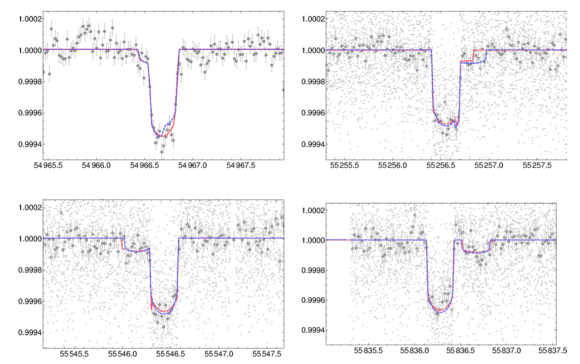The latest exciting undertaking in exoplanet research is the search for exomoons. A team led by Dr. David Kipping at the Harvard-Smithsonian Center for Astrophysics has jumped at this challenge. After having theoretically proven that detecting an Earth-sized exomoon is possible, the team carried out the first detailed search for an exomoon.
Are you leaning forward on the edge of your seat awaiting the results? Well here you go: the data show no evidence of a moon. That’s simply the luck of the draw. We didn’t discover an exoplanet on our first try either. I believe that this non-detection shows that we’re on the verge of our next greatest discovery.
The reasons for searching for exomoons are abundant. “Exomoons may be frequent, habitable abodes for life and so far we know next to nothing about the underlying frequency of such objects in the cosmos,” Dr. Kipping told Universe Today. “They also play an important role in the habitability of those planets which they orbit, for example the Moon is thought to stabilize the axial tilt of the Earth and so too the climate.”
The project titled “The Hunt of Exomoons with Kepler,” more commonly known as HEK, was formed with these reasons in mind. As such, the HEK project will search for exomoons that are likely to be habitable.
The first target is Kepler-22b – the first transiting exoplanet to have been detected in the habitable zone of its host star. At 2.4 Earth radii, it is too large to be considered an Earth-analog, but it could easily have an Earth-sized moon
There are currently two methods in which we may detect exomoons.
1.) Dynamic effects – the exomoon tugs the planet, which causes deviations in the times and durations of the host planet’s transits. This is similar to the radial velocity technique for detecting exoplanets.
2.) Transit effects – the exomoon may transit the star immediately before or just after the planet does. This will cause an added dip in the observed light. See this video for a great demonstration. This is similar to the light curve technique for detecting exoplanets.
The team modeled the initial transit light curves of Kepler-22b. They then injected an Earth-sized moon into the system in order to analyze the effects. While this caused clear variations in the light curve, such variations had to be above the level of noise.
As such, they also injected noise in the light curves, which mirrors that of the Kepler data. In the end, the variations in a star’s light curve due to the presence of an exomoon are much higher than the noise. The team is able to recover the correct answer with extremely high confidence.

The real data does not show deviations like the previous figure does. This non-detection implies that there is no moon with a mass greater than 0.54 times the mass of the Earth. While there is no Earth-analog in this system, there may be a smaller undetectable moon.
I asked Dr. Kipping about our chances of success in other systems. His answer: “That depends upon nature herself!” We have no idea how regularly nature produces moons in other solar systems. “There is nothing more exciting than working on a project where the answer is wholly unknown.”
But remember: two decades ago we were unsure if nature regularly produced planets. We have since observed them in abundance. I have to believe that with 168 moons in our solar system alone, we’re likely to find them in other systems. We’re on the verge of the next greatest discovery. So stay tuned because I promise I’ll be writing about it when it happens.
Source: Kipping et al. 2013


Well done Shannon! Great article on a variation of a new branch of astronomy. I enjoyed your article very much. As one who is involved with observing the transits of extrasolar planets, I found your article accurate and interesting!
John S. Gianforte
Blue Sky Observatory
Very well done indeed… I’ll be staying tuned.
cant wait until they find the first exomoon or exomoons!